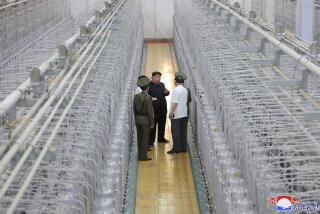Japan urges residents near nuclear plant to leave
- Share via
Reporting from Tokyo — Japan’s government urges residents within 18 miles of the stricken Fukushima nuclear power plant to leave their homes, as new information suggests that the core of reactor No. 3 may have been breached.
Japan’s government Friday urged residents within 18 miles of the stricken Fukushima nuclear power plant to leave their homes, as new information suggested that the core of reactor No. 3 may have been breached.
Although people living within 12 miles of the plant were evacuated early in the crisis, those between 12 and 18 miles had been told it was safe to remain as long as they stayed indoors. Authorities have suggested they might expand the mandatory evacuation zone.
Photos: Japan’s earthquake, tsunami and nuclear crisis
“It has become increasingly difficult for goods to arrive, and life has become harder,” Chief Cabinet Secretary Yukio Edano said at a news conference Friday. He called on local governments near the plant to encourage people to leave.
It was not immediately clear how many people remained within 18 miles of the facility, and Edano’s comments sowed confusion among residents and local officials. With more than 200,000 victims of the March 11 earthquake and tsunami in emergency shelters, many of them elderly, evacuations of thousands more could further strain resources.
Prime Minister Naoto Kan addressed the nation Friday evening, urging victims to “summon the courage to keep moving forward” and pledging the “utmost” effort to rebuild the country.
Under pointed questioning from reporters, Kan said the situation at the Fukushima plant remained “grave and serious.”
“We are not in a position where we can be optimistic,” Kan said. “We must treat every development with the utmost care.”
Dressed in the blue jumpsuit that has become a trademark of the disaster, Kan apologized to farmers and business owners around the plant for the radioactive contamination and sought to rebut criticism that his government had failed to relay clear and timely information about the situation to the Japanese public and foreign governments.
The U.S. government has advised keeping 50 miles away from the nuclear plant, raising questions among some Japanese about whether officials here have played down the danger. Foreign recommendations on some other issues, such as the safety of tap water in Tokyo, have also been tougher.
“Each country has unique standards,” Kan said.
His remarks came after Japanese nuclear safety officials said they suspected a breach in the core of reactor No. 3, which contains highly carcinogenic plutonium.
Their suspicion stems from measurements of radiation in water that contaminated two workers Thursday — levels that were 10,000 times what would be expected inside an operating reactor. That could indicate there was damage to the core and a leak in the containment vessel, the agency acknowledged Friday.
“The source of the radiation seems to be the reactor core,” said Nuclear and Industrial Safety Agency official Hidehiko Nishiyama. It is “more likely” that the radiation was from the core than from the spent-fuel pool, he said.
U.S. nuclear experts said information from Japanese officials about reactor No. 3 was inconclusive — pipes, valves or fittings, rather than the containment vessel, could be leaking, they said.
David Lochbaum, a commercial reactor expert at the Union of Concerned Scientists, said pressure readings inside the reactor cast doubt on the idea that the reactor vessel had been breached
“It’s contradictory data,” he said.
Edwin Lyman, a physicist with the scientists group, said the amount of radioactive iodine released so far indicated “limited damage” to the fuel.
But if the reactor core was breached by uranium fuel that melted through the bottom of the vessel, it would create the potential for vastly greater releases of radioactive iodine and cesium.
Separately, the U.S. Energy Department on Friday released radioactivity measurements from around the plant that show a decline from the levels of two days ago.
The data indicate that a hot spot in the range of 13 to 25 miles from the plant that recorded 12.5 millirem per hour on March 19 had dropped to no more than 2.17 millirem per hour. Even the lower levels, however, are about 31 times the average background dose Americans receive annually.
Japan has been cooling the reactors and spent-fuel pools with seawater, which American officials warn could cause equipment to seize up and corrode, complicating the task of stabilizing the reactors.
Japanese officials said the U.S. was dispatching a vessel from the Yokosuka naval base with fresh water for the site.
The death toll from the March 11 quake and tsunami rose to 10,102, with 17,053 missing, the National Police Agency said.
Photos: Japan’s earthquake, tsunami and nuclear crisis
Times staff writer Ralph Vartabedian in Los Angeles contributed to this report.
More to Read
Sign up for Essential California
The most important California stories and recommendations in your inbox every morning.
You may occasionally receive promotional content from the Los Angeles Times.














